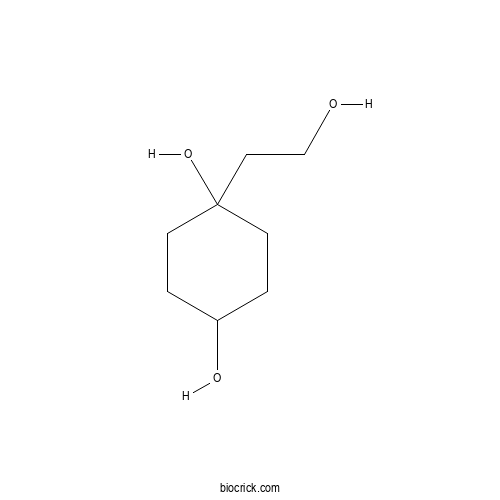IsorengyolCAS# 101489-38-7 |

- Rengyol
Catalog No.:BCN4481
CAS No.:93675-85-5
Quality Control & MSDS
3D structure
Package In Stock
Number of papers citing our products

| Cas No. | 101489-38-7 | SDF | Download SDF |
| PubChem ID | 363707 | Appearance | Powder |
| Formula | C8H16O3 | M.Wt | 160.2 |
| Type of Compound | Other NPs | Storage | Desiccate at -20°C |
| Solubility | Soluble in Chloroform,Dichloromethane,Ethyl Acetate,DMSO,Acetone,etc. | ||
| Chemical Name | 1-(2-hydroxyethyl)cyclohexane-1,4-diol | ||
| SMILES | C1CC(CCC1O)(CCO)O | ||
| Standard InChIKey | TWORTZAXDSRCIT-UHFFFAOYSA-N | ||
| Standard InChI | InChI=1S/C8H16O3/c9-6-5-8(11)3-1-7(10)2-4-8/h7,9-11H,1-6H2 | ||
| General tips | For obtaining a higher solubility , please warm the tube at 37 ℃ and shake it in the ultrasonic bath for a while.Stock solution can be stored below -20℃ for several months. We recommend that you prepare and use the solution on the same day. However, if the test schedule requires, the stock solutions can be prepared in advance, and the stock solution must be sealed and stored below -20℃. In general, the stock solution can be kept for several months. Before use, we recommend that you leave the vial at room temperature for at least an hour before opening it. |
||
| About Packaging | 1. The packaging of the product may be reversed during transportation, cause the high purity compounds to adhere to the neck or cap of the vial.Take the vail out of its packaging and shake gently until the compounds fall to the bottom of the vial. 2. For liquid products, please centrifuge at 500xg to gather the liquid to the bottom of the vial. 3. Try to avoid loss or contamination during the experiment. |
||
| Shipping Condition | Packaging according to customer requirements(5mg, 10mg, 20mg and more). Ship via FedEx, DHL, UPS, EMS or other couriers with RT, or blue ice upon request. | ||

Isorengyol Dilution Calculator

Isorengyol Molarity Calculator
| 1 mg | 5 mg | 10 mg | 20 mg | 25 mg | |
| 1 mM | 6.2422 mL | 31.211 mL | 62.422 mL | 124.8439 mL | 156.0549 mL |
| 5 mM | 1.2484 mL | 6.2422 mL | 12.4844 mL | 24.9688 mL | 31.211 mL |
| 10 mM | 0.6242 mL | 3.1211 mL | 6.2422 mL | 12.4844 mL | 15.6055 mL |
| 50 mM | 0.1248 mL | 0.6242 mL | 1.2484 mL | 2.4969 mL | 3.1211 mL |
| 100 mM | 0.0624 mL | 0.3121 mL | 0.6242 mL | 1.2484 mL | 1.5605 mL |
| * Note: If you are in the process of experiment, it's necessary to make the dilution ratios of the samples. The dilution data above is only for reference. Normally, it's can get a better solubility within lower of Concentrations. | |||||

Calcutta University

University of Minnesota

University of Maryland School of Medicine

University of Illinois at Chicago

The Ohio State University

University of Zurich

Harvard University

Colorado State University

Auburn University

Yale University

Worcester Polytechnic Institute

Washington State University

Stanford University

University of Leipzig

Universidade da Beira Interior

The Institute of Cancer Research

Heidelberg University

University of Amsterdam

University of Auckland

TsingHua University

The University of Michigan

Miami University

DRURY University

Jilin University

Fudan University

Wuhan University

Sun Yat-sen University

Universite de Paris

Deemed University

Auckland University

The University of Tokyo

Korea University
- 4-(Acetoxymethyl)phenyl glucoside
Catalog No.:BCN0480
CAS No.:188290-72-4
- Kokusaginine
Catalog No.:BCN0479
CAS No.:484-08-2
- 2,4,6-Trihydroxy-3-prenylacetophenone
Catalog No.:BCN0478
CAS No.:27364-71-2
- Ferruginoside C
Catalog No.:BCN0477
CAS No.:213991-03-8
- (±)-8-Gingerol
Catalog No.:BCN0476
CAS No.:77398-92-6
- 2',3'-Dehydromarmesin
Catalog No.:BCN0475
CAS No.:28664-60-0
- Polypodine B 20,22-acetonide
Catalog No.:BCN0474
CAS No.:159858-85-2
- Acrotrione
Catalog No.:BCN0473
CAS No.:2349327-31-5
- 1,4-Dihydro-1-methyl-4-oxonicotinamide
Catalog No.:BCN0472
CAS No.:769-49-3
- 1-O-Cinnamoylglucose
Catalog No.:BCN0471
CAS No.:40004-96-4
- 1-O-p-Coumaroylglucose
Catalog No.:BCN0470
CAS No.:7139-64-2
- 5-endo-Hydroxyborneol
Catalog No.:BCN0469
CAS No.:68738-10-3
- Stigmalactam
Catalog No.:BCN0482
CAS No.:289499-72-5
- [6]-Gingerol
Catalog No.:BCN0483
CAS No.:39886-76-5
- Acrovestone
Catalog No.:BCN0484
CAS No.:24177-16-0
- Marionol
Catalog No.:BCN0485
CAS No.:65602-55-3
- Verproside
Catalog No.:BCN0486
CAS No.:50932-20-2
- 5-Hydroxy-6,7,3',4'-tetramethoxyflavone
Catalog No.:BCN0487
CAS No.:21763-80-4
- Piperdardine
Catalog No.:BCN0488
CAS No.:188426-70-2
- 4''-O-Methylcatalposide
Catalog No.:BCN0489
CAS No.:887140-17-2
- Apigenin 7,4'-di-O-alloside
Catalog No.:BCN0490
CAS No.:95693-63-3
- Tsaokoin
Catalog No.:BCN0491
CAS No.:343605-41-4
- Piperchabamide B
Catalog No.:BCN0492
CAS No.:807618-21-9
- Piceatannol 4'-O-glucoside
Catalog No.:BCN0493
CAS No.:116181-54-5
[Chemical constitunents of seeds of Oroxylum indicum].[Pubmed:23672042]
Zhongguo Zhong Yao Za Zhi. 2013 Jan;38(2):204-7.
OBJECTIVE: To study the chemical constituents in the seeds of Oroxylum indicum. METHOD: Twenty compounds were isolated and purified by silica gel, and Sephadex LH-20 column chromatography, and their structures were determined by spectroscopic analysis including NMR and MS. RESULT: Twenty compounds were isolated and identified as oroxin A (1), oroxin B (2), chrysin (3), baicalein (4), quercetin (5), apigenin (6), kaempferol (7), quercetin-3-O-ara-binopyranoside (8), lupeol C9), lup-20 (29)-ene-2alpha,3beta-diol (10), pinosylvin (11), dihydropinosylvin (12), cholest-5-ene-3, 7-diol (13), rengyol (14), Isorengyol (15), zarzissine (16), (E) -pinosylvin-3-O-beta-D-glucopyranoside (17), adenosine (18), sitosterol (19) and daucosterol (20). CONCLUSION: Compounds 11-13 and 15-18 were obtained from the genus Oroxylum for the first time, and except compound 18, the remaining 6 compounds were obtained from the family Bignoniaceae for the first time.
New phenolic glucosides from the leaves of Eurya tigang.[Pubmed:1431944]
J Nat Prod. 1992 Sep;55(9):1270-4.
Three new compounds, 6'-O-coumaroyl-1'-O-[2-(4-hydroxyphenyl)ethyl]-beta-D-glucopyra nos ide [1] (eutigoside A), 6'-O-coumaroyl-1'-O-[2-(1-hydroxy-4-oxo-2,5-cyclohexadien-1- yl)ethyl]-beta-D-glucopyranoside [2] (eutigoside B), and 6'-O-cinnamoyl-1'-O-[2-(1-hydroxy-4-oxo-2,5-cyclohexadien-1-yl)eth yl]- beta-D-glucopyranoside [3] (eutigoside C) have been isolated from the leaves of Eurya tigang, along with other known compounds (afzelin, quercitrin, p-coumaric acid, methyl-alpha-D-fructofuranoside, Isorengyol, and euryanoside). Their structures were determined by chemical and spectroscopic methods (uv, ir, ms, 1H-1H COSY, and 1H-13C COSY).
Polar Constituents of Calceolaria ascendens1.[Pubmed:17265284]
Planta Med. 1988 Aug;54(4):347-8.
A new phenylpropanoid glucoside, 1'- O-beta- D-(3,4-dihydroxy-beta-phenyl)-ethyl-4'- O-caffeoyl-beta- D-apiosyl-(1'''-->3')-glucopyranoside, named calceolarioside E, was isolated from CALCEOLARIA ASCENDENS Lind., together with two other phenylpropanoid glucosides, verbascoside and forsythoside A, and cyclohexanols rengyol, Isorengyol, and 4-hydroxy-4-(2'-hydroxyethyl)-cyclohexanone.


